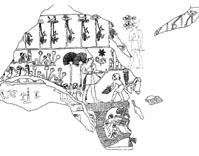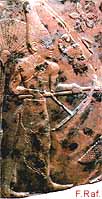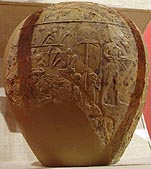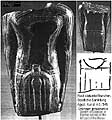KING SCORPION (II)*
Francesco Raffaele
(Excerpt after my DYNASTY 0
page.
Cf. F. Raffaele, Dynasty 0, in: S. Bickel, A. Loprieno (eds.) Basel Egyptology Prize 1, Aeg Helv 17, 2003, 99-141; p. 112 - PDF)
* Preliminary note: For some years (late 1990s - early 2000s) most of the Egyptologists have accepted the status of a Kings Scorpion (I) as the owner of the Abydos tomb U-j, after G. Dreyer's remarkable publication (1998) of this invaluable and much publicised discovery (Naqada IIIA1/IIIa2). This king was also tentatively identified with the victorious ruler depicted in the Gebel Tjauti graffito, where a falcon and a scorpion are incised though not directly related with the ruler's representation (i.e. not carved directly above the sovereign figure, but on the opposite side of the panel).
Consequently, the already known and later king Scorpion (Naqada IIIB/C1), to whom the present page is dedicated, has been distinguished naming him "Scorpion II", in order to avoid confusion with the earlier homonymous king.
However, more recently, some scholars have raised objections to the reading of the tomb U-j inscribed materials (incised ivory tags, painted marks on wine jars) as personal (royal-) names**, proposing a more likely interpretation of the scorpion signs and other hieroglyphs as place-names (indicating the localities where gravegoods were delivered from/to, in the case of the U-j tomb attestations).
In the lack of a "king Scorpion I", it thus seems that also the designation of "Scorpion II", commonly adopted in the last five years, could be quite easily abandoned. **[Cf. Table 1 in "Dynasty00" for a similar criticism to the interpretations of the graffiti on the Koptos Colossi].
ARCHAEOLOGICAL EVIDENCE: THE SOURCE(S)
King SCORPION is known by a single inscribed
ceremonial object (although a few more have been tentatively ascribed to him, as I'm illustrating below).
Style, epigraphy, provenance and
typology of this document clearly indicate a datation within the period of the last reigns of Abydos' Dynasty 0: not much earlier than Horus Ka and certainly not later than Narmer's age. In the lack of his tomb at Abydos, he might be thought to represent a local 'Gegenkönig'
(as Dreyer defines Horus Crocodile for the Fayum area); these sovereigns were possibly the last expressions
of ancient local indipendent ruling lineages which ceased to exist
when the powerful kings of the Thinite region moved northward and southward to occupy
the territories with which, until then, they seem to have entertained mostly peaceful,
commercial relations. This increased their power making them responsible for the political Unification of Egypt.
The status of king Scorpion
at Hierakonpolis is hard to explain and Dreyer thinks this was a Thinite
ruler whose Abydene tomb has not yet been discovered (but see below). Indeed the different writing of his royal name and titulary (rosette plus name instead of name within the serekh) and the provenance of his macehead from the "Main Deposit" of Nekhen do not
necessarily indicate a Hierakonpolite origin for Scorpion: Iry
Hor had an unusual royal name designation too, and so did Narmer (in some of his Horus name variations) who is similarly known by different finds from
the temple of Nekhen. The discrepancies in royal titularies witness the slightly different traditions subsisting in the various local polities and a early stage in the development of (quasi-)divine kingship ideology.
Despite the lack of predynastic king lists (and of their archaic rough equivalents, as are multiple royal names' stone vessels inscriptions and "necropolis sealings"; but for a possible exception cf. the conclusions) the Abydos late Dynasty 0 line (monarchs buried in the cemetery B) appears quite defined. It is obviously possible that new royal names might emerge or that those of kings known for discoveries in Lower Egypt or elsewhere might be found in the cemetery B of Abydos as well. Yet it is far less verisimilar to suppose that this could happen with a late Dynasty 0 (i.e. late Naqada IIIB) king as Scorpion, (unless we admit that scanty evidence might reflect an ephemeral, short reign).
Iry-Hor, Horus Ka and Horus Narmer are fairly well attested royal names, not only at Abydos (see this serekh list).
On the other hand the kind of attestations from Hierakonpolis élite cemeteries (loc. 6) is noteworthy different from the Abydene one (e.g. the use of sealings and the amount of their remains from the richest tombs of the two regions).
It still seems possible to me that Scorpion was a roughly contemporary of Hor-Ka, and that the former ruled in the region of Nekhen (but cf. conclusions).
The giant Scorpion macehead from Hierakonpolis (it's larger than Narmer's one) is a
masterpiece of the period; for this reason (as well as for its being virtually
the only object surely attributable to this king, and for the debates on the
ritual it depicts and some further reasons, cf. below) this important artefact is fairly well known in Egyptology and there is no need to add
a detailed description here. I only remark again that the name of this king is not
written within the serekh and is not surmounted by Horus; the expression for
'sovereign' is rendered by the 'Rosette' [28]. K. Cialowicz thinks that, at
the right end of the rows of Rekhyt-bows standards, in the
upper registers, there would be the standing king Scorpion represented
(at higher scale) with the Red Crown of Lower Egypt on his head (cfr. Adams - Cialowicz,
Protodynastic Egypt, 1997, 8, fig.1 = line drawing below, left).
For an alternative reconstruction by Midant-Reynes and Gautier (who suggest a second Royal Macehead might have been part of Scorpion's one) cf. below.
For the Scorpion macehead (Oxford, Ashmolean Mus., E3632) cf. the bibliography. For more contemporary carved objects see my page here.
|
Another "Royal" macehead from
the same cachette at Hierakonpolis (UC, London 14898), even more fragmentary than the Scorpion's one, shows a king sitting under a canopy, wearing the Heb Sed robe and red crown; Arkell interpreted a slightly visible
sign before the king's head as a Scorpion [29]; Adams (1974) found no trace of the
rosette in a break in front of the red crown curl; therefore the object
could have even belonged to another king of the period immediately preceeding Narmer: I would suggest that the fragmentary glyph might be perhaps interpreted
as a standard with a crocodile whose tail is hanging down on the right (Horus Crocodile?).
Cialowicz has offered a convincing reconstruction of the scene as the Sed
celebration after a military victory of Scorpion (or Narmer); to the right
of the sitting king, in the centre of the scene, there is a large falcon
(turned towards the king) holding in its claws a rope which directs to
the right-end of the preserved fragment. Behind the falcon and in a lower position, appear a number of prisoners (one ear is clearly
visible) held with the rope by
the falcon god Horus, who gathers (?) them in front of the ruler.
The scene of this mace is reconstructed by Midant-Reynes and Gautier (1995, fig. 15) as forming a portion on the right hand of the major extant relief of the Scorpion macehead in Oxford (cf. above). The canopy with the sitting king is hypothesised as being placed in front of the dancers and repwt (repit) processions; the 'recumbent' falcon, which in the other reconstructions of the Royal macehead faces the sitting king, would have to be placed, according to them, behind the king's Heb Sed pavillion, facing the two standard bearers who are represented on the right of Scorpion's name.
A graffito at Gebel Sheikh Suleiman [30] in Upper Nubia, shows a scorpion
with a prisoner into its claws; two more human figures, with a bow and
false tails, are turned towards the captive and the scorpion. This scene
should, in my opinion, be far earlier than Scorpion
II, whose period it has been also referred to: it could be nonetheless related to a chief, but I would tentatively suggest a date in the Naqada
IIIa (or even late Naqada II) period rather than a later one.
The date is far more certain for a pair of limestone vessels from Quibell's Hierakonpolis excavations (id., Hierakonpolis I, 7-8) but, contrarily to the opinion of the publisher (ibid.), the reliefs of falcons (Andjety / Nemty), scorpions, and bows + rekhyt birds surrounding
the body of one of these stone vases (op. it., XIX,1 , XXV, photo below) can't be attached with any confidence to a "Dyn 0 ... Horus Scorpion" as neither can the isolated scorpion on the other vessel (op. cit., XVII,1 , XXXIII, 1). A larger
group of objects has been assigned to this king by P. Kaplony, with alternate degrees of confidence: but it can't be really assumed that almost any known
late predynastic representation of scorpions ought to refer to him or to other predynastic Scorpion kings [31].
If not to be connected to otherwise unattested Serkit / Selkit or Djaret (female !) gods (but cf. LÄ V, 987-990 and Hendrickx et al., op. cit. in note 31), the scorpion may represent a toponym, as is the case for the painted marks on jars and the incided tags from the older tomb U-j in Abydos (these inscriptioins, as I have summarized in the premise, had lead Dreyer to identify a King Scorpion I as the owner of that tomb). It is noteworthy that the Main Deposit of Hierakonpolis even produced a number of alabaster offering dishes with incised hieroglyphs of scorpion (falcon in one case) + reversed ka-arms and scorpion figurines similar to those portraying various animals/objects found in some early cachettes (Tell Ibrahim Awad, Abydos, Elephantine).
The tomb of Scorpion (II) has never been found; G. Dreyer and M. Hoffman have
speculatively proposed it might have been respectively the four chambers Abydos tomb B50 and the
Hierakonpolis cemetery in locality 6, tomb 1 [32]. The slight traces of king Scorpion hinder any safe reconstruction about the place of origin of this obscure
sovereign, the location and extent of his territory and the role he'd played in Late Predynastic Egyptian history.
In the light of the recent trend to interpret royal representations on ceremonial objects at standardized, symbolic, ritual scenes (i.e. neither chronicles nor even commemorations of real events!), little could be deduced from the analysis of the macehead (but cf. the conclusions).
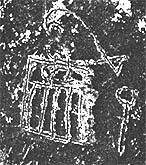 |
A royal name within a falcon topped serekh incised on a
jar from tomb 160.1 at Minshat Abu Omar has been alternatively read as
Aha and Scorpion. The sign does look like a scorpion, curved with both
the tail (which is drawn above the body) and the head looking rightward,
whereas the falcon looks towards the left.  Van
den Brink has proposed that this sign might be an upset variant of the
coil identified by Dreyer on two vessels and a seal impression from Tarkhan
(cfr. below) [33].
Van
den Brink has proposed that this sign might be an upset variant of the
coil identified by Dreyer on two vessels and a seal impression from Tarkhan
(cfr. below) [33].
These ink-inscribed cylinder vessels
were found by Petrie [34] in tombs 1549 and 315. Kaiser and Kaplony read
their serekhs name as Scorpion (with the tail now curved below the animal);
but this is hard to accept, because the scorpion would have on both the examples
an opposite orientation than the falcon above the serekh; Dreyer [35]
has introduced, to account for these two serekhs (but not the M.A.O. one),
a king CROCODILE, ruler of the Fayum region.........
Finally there is an inscription in a serekh on the Munchen Staat. Samml. statuette (see note 30) which has been read Nar(mer); this could be perhaps a scorpion (indeed neither of the two readings definitively convinces). (Continues on Dyn 0 page)
For the possible datation (proposed by G. Dreyer, in
Umm el-Qaab I, 1998, 173ff.) of the Tehenu
palette (or Towns palette) to the reign of King Scorpion (II) cf. Dynasty
00 page. Also L.D. Morentz has recently (2004, 144ff.) reaffirmed the connection of the "Buto Palette" with king Scorpion.
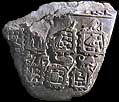
CONCLUSIONS
As it has been already anticipated, the existence of the Late Predynastic king Scorpion is clearly shown by only one powerfact, his decorated macehead.
The ceremonial object and the ruler to which it refers, have been studied from various points of view and with different purposes. We may cite (also cf. Cialowicz 2001, 197ff.; Gautier, Midant-Reynes, 1995) the attempts to identify the ritual or the effective event which is represented: the foundation of the temple of Nekhen / Hierakonpolis (Baumgartel) or of Pe / Buto (Godron; L. Morentz), or of the very capital of Memphis (Arkell, identifying him with Menes and quoting Manetho's epitomes' entry about this king); the celebration of part of the Heb Sed ritual (Vikentiev; Baines; Cialowicz), of agricultural rites of fertility (Weill; Barta; Baines), the opening of a channel (and a witness of early state sponsored irrigation: Vandier, 1952; Butzer, 1976; or a means to redefine kingship through the "Water power" and the link that Nile control provides between the king and the gods shrines and between the Two Lands themselves: Gautier, Midant-Reynes, 1995); the (commemoration of the) conquest of Lower Egypt (Schott; Needler)...
The royal figure has been also much debated: the king's name has been regarded as an indication of a different ruling line (Hierakonpolis) in which the rosette would have a similar meaning as the Thinite serekh. Notwithstanding the possibly different origin and controlled territory, it has been often evidenced that the general relief style and details in human protraiture would seem to make the Hierakonpolis mace-heads very close in time with each others, if not the work of the same hand (Baumgartel).
On the other hand some authors have simply denied the existence of a Scorpion king, eventually equating him with Narmer (Vikentiev 1950; Baumgartel 1960; Malek, 1986; Menu, 1996; Lankester 2011) on the base of the too close analogy of artistic canons and style of the reliefs on his macehead when compared to those on Narmer macehead and palette and above all by virtue of the assumption that rosette + scorpion emblem would be a mere additional title, attribute or appellation of Horus Narmer rather than a different iconographic device to display royal titularies (thus dismissing the possibility that there might still have been at that time more than one system to identify late Naqada IIIB rulers, other than with serekhs. This is in my opinion very unlikely, if not wrong at all).
Even strictly considering the unique certain source, which is evidently the most important one, some interesting conclusions can be attempted about the status of the individual in object and the political outline at the end of Naqada IIIB period (c. 3100C).
We must assume that what is left on the mace-head reliefs has at least a minimum relationship with the actual geo-political situation of that time. I mean that even if not necessarily a narration of historical circumstances, or even less extremely a mere commemoration of (past?) events, the representations should reflect, with some degree of concreteness, the effective general state of things in the Nile Valley few generation before the beginning of the First Dynasty.
It cannot be denied that these ritual object might have magical purposes, thus acting as a means to enhance royal power through depictions of victories, but it also logical to think that if such apotropaic needs were so manifest in Late Predynastic "art", this couldn't depend only on a sterile development of the ideology of power. There must have been some effective source for the tension and aggressive behaviour which emerges in the imagery of these categories of craftworks', even admitting that the message they were apt to convey was the result of a deeply meditated (planned) and averagely canonized symbolic language.
Many artefacts represent violent scenarios, with more or less direct hints at battles (generally their aftermaths: prisoners rows, their punishment, humiliation or ritual killing and related triumphal ceremonies; perhaps also military raids with boats are known): cf. Battlefield, Bull, Tehenu and contemporary palettes, the Metropolitan Museum Knife handle. On a number of these fragmentary objects it can be easily observed that the representation is clearly structured as taking place in the Delta (lotus plants, Lower Egyptian Pr-Nw shrines, channels) and eventually in the Buto region (P-mat and Djebawtj heroon as towns designations on the Tehenw / Towns palette, Rekhyt + P-mat on the Plover palette; Palm + mat on the Scorpion mace-head).
In many cases, standards, which have been recently demonstrated to correspond to proto-nomes entities possibly reflecting local polities or regional subdivisions of the main proto-states of that period (cf. J. Kahl, 2001 and E.M. Engel, 2006 for early occurrences of toponyms and proto-nomes in the economic sphere, i.e. on jar potmarks, tags / labels and seal impressions of Naqada IIIA1-IIID), lively act against enemies or vs. enemy emblems (in our case the Rekhyt lapwings).
This is an important indication that there was some kind of alliances among Upper Egyptian regional units, although it is hard to determine the level of mutual political independence of each locality. It is generally thought that by Late Naqada IIIB only very few super regional entities, "proto-states", survived or developed along the Nile Valley.
Now what does king Scorpion mace-head show and which are the possible implications of the figurative message it displays, as far as geographic and political clues?
...
